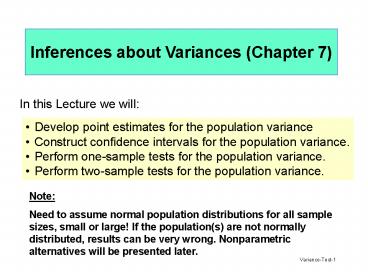Variance-Test-1 - PowerPoint PPT Presentation
Title:
Variance-Test-1
Description:
Title: Paired Data and Inferences on Popn Variances Subject: STA 6166 Author: Portier, Kenneth Last modified by: atrindad Created Date: 1/4/1999 1:49:36 PM – PowerPoint PPT presentation
Number of Views:72
Avg rating:3.0/5.0
Title: Variance-Test-1
1
Inferences about Variances (Chapter 7)
In this Lecture we will
- Develop point estimates for the population
variance - Construct confidence intervals for the population
variance. - Perform one-sample tests for the population
variance. - Perform two-sample tests for the population
variance.
Note Need to assume normal population
distributions for all sample sizes, small or
large! If the population(s) are not normally
distributed, results can be very wrong.
Nonparametric alternatives will be presented
later.
2
Point Estimate for ?2
The point estimate for ?2 is the sample variance
What about the sampling distribution of s2?
(I.e. what would we see as a distribution for s2
from repeated samples).
If the observations, yi, are from a normal (?,?)
distribution, then the quantity
has a Chi-square distribution with df n-1.
3
Chi Square (?2) Distribution
Non-symmetric. Shape indexed by one parameter
called the degrees of freedom (df).
4
Chi Square Table
Table 7 in Ott and Longnecker
5
Confidence Interval for ?2
has a Chi Square Distribution, then a 100(1-?)
CI can be computed by finding the upper and lower
?/2 critical values from this distribution.
If
6
Consider the data from the contaminated site vs.
background.
s2 1.277
7
Hypothesis Testing for s2
What if we were interested in testing
Rejection Region 1. Reject H0 if ?2 gt
?2df,? 2. Reject H0 if ?2 lt ?2df,1-? 3. Reject
H0 if either ?2 lt ?2df,1-?/2 or ?2 gt ?2df,?/2
8
Tests for Comparing Two Population Variances
Objective Test for the equality of variances
(homogeneity assumption).
9
F distribution
- Can assume only positive values (like ?2, unlike
normal and t). - Is nonsymmetrical (like ?2, unlike normal and t).
- Many shapes -- shapes defined by numerator and
denominator degrees of freedom. - Tail values for specific values of df1 and df2
given in Table 8.
df1 relates to degrees of freedom associated with
s21
df2 relates to degrees of freedom associated with
s22
10
F Table
Table 8
Numerator df df1.
Note this table has three things to specify in
order to get the critical value.
Denominator df df2.
4.28 5.82
Probability Level
11
Hypothesis Test for two population variances
versus
12
Example
Study Site Samples
Background Samples
T.S.
R.R.
Reject H0 if F gt Fdf1,df2,? where df1n1-1 and
df2n2-1
? 0.05, F6,6,0.05 4.28 One-sided
Alternative Hypothesis
Reject H0 if F gt Fdf1,df2,?/2 or if F lt F
df1,df2,1-?/2
? 0.05, F6,6,0.025 5.82, F6,6,0.975 0.17
Two-sided Alternative
Conclusion Do not reject H0 in either case.
13
(1-?)100 Confidence Interval for Ratio of
Variances
Note degrees of freedom have been swapped.
14
Conclusion
While the two sample test for variances looks
simple (and is simple), it forms the foundation
for hypothesis testing in Experimental Designs
(ANOVA).
- Nonparametric alternatives are
- Levenes Test (Minitab)
- Fligner-Killeen Test (R).
15
Software Commands for Chapters 5, 6 and 7
MINITAB Stat -gt Basic Statistics -gt 1-Sample z,
1-Sample t, 2-Sample t, Paired t,
Variances, Normality Test. -gt Power and
Sample Size -gt 1-Sample z, 1-Sample t, 2-Sample
t. -gt Nonparametrics -gt Mann-Whitney
(Wilcoxon Rank Sum Test) -gt
1-sample Wilcoxon (Wilcox. Signed Rank
Test) R t.test( ) 1-Sample t, 2-Sample t,
Paired t. power.t.test( ) 1-Sample t, 2-Sample
t, Paired t. var.test( ) Tests for homogeneity
of variances in normal populations. wilcox.test(
) Nonparametric Wilcoxon Signed Rank Rank Sum
tests. shapiro.test( ), ks.test( ) tests of
normality.
16
- Example
- Its claimed that moderate exposure to ozone
increases lung capacity. 24 similar rats were
randomly divided into 2 groups of 12, and the 2nd
group was exposed to ozone for 30 days. The lung
capacity of all rats were measured after this
time. - No-Ozone Group 8.7,7.9,8.3,8.4,9.2,9.1,8.2,8.1,8.
9,8.2,8.9,7.5 - Ozone Group 9.4,9.8,9.9,10.3,8.9,8.8,9.8,8.
2,9.4,9.9,12.2,9.3 - Basic Question How to randomly select the rats?
- In class I will demonstrate the use of MTB and R
to analyze these data. (See Comparing two
populations via two sample t-tests in my R
resources webpage.)































